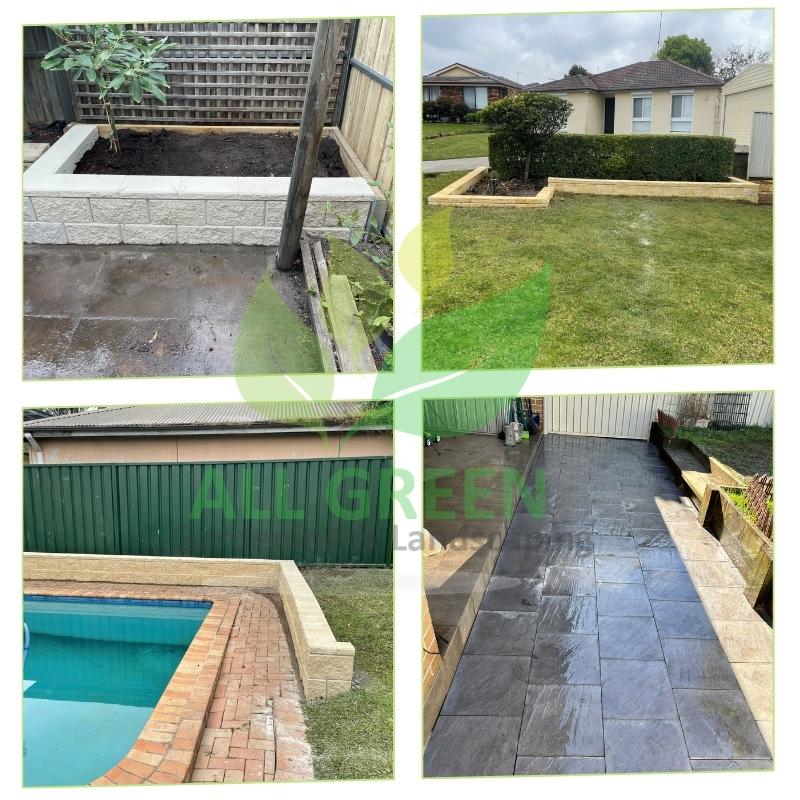Unlocking Your Home’s Potential with Landscaping Macquarie Fields Services. A well-designed landscape enhances not just your garden but also your entire home. Importantly, landscaping goes beyond just visual appeal; it increases your property value. With All Green Gardening Services, you can turn your dream yard into a reality. We are just a phone call away, get ready to transform your outdoor space.

Looking for a Local Landscaper in Macquarie Fields? 🌱
Most people search for “landscaper near me” to find someone local. Discover us! We’re your go-to for landscape garden maintenance, offering services like retaining walls, outdoor space design, garden planning, and complete landscaping solutions.
Macquarie Fields’s Best Landscaping Company Is Here
Our landscape design services excel in quality and affordability, no matter the project’s scope. Count on our expert team for a comprehensive structural landscaping solution.
We’re your local option for budget-friendly services, backed by our Best Price Guarantee!
When excellence and beauty intertwine in NSW landscaping, it’s All Green Gardening & Landscaping at work. Our expertise, from mulching to tree removal, elevates gardens into art. Boost property value with enchanting outdoors. Begin the green journey with us.
We also serve and have landscaping projects in the following surrounding suburbs:
Choosing All Green Gardening – The Benefits:
- Comprehensive Service: Paving, tree removal, weeding – we excel in all.
- Property’s Best Friend: Add significant value to your asset with our services.
- Crafted for You: Solutions that resonate with your garden’s individuality.
- Environmentally Conscious: Eco-friendly techniques at the heart of our approach.
- Masters at Work: Our team of experts ensures perfection in every project.
- Customer-Centric: Your satisfaction is our success; we aim for both.
Macquarie Fields Landscaping Services by All Green Gardening & Landscaping
We’re All Green Gardening and Landscaping, known for our skill in crafting inviting, organic landscapes that enhance the appeal of residential and commercial properties with our expert landscape design. Stay engaged with us through our Facebook Page. From backyard makeovers in Macquarie Fields to larger-scale ventures, our dedication remains unchanged – providing outstanding customer service and expert Macquarie Fields landscaping. Our services encompass both residential and commercial landscaping, in close collaboration with our talented designers and installers.
For your grand design ventures, our licensed landscape designers will be present to create the ultimate design. A site consultation is on the agenda. Our designers will explore your project and outline the work involved. Upon completion, we’ll offer a comprehensive landscape design consultation for you.
Why Trust All Green Gardening & Landscaping? ⭐
We’ve proudly provided top-notch landscaping services in Macquarie Fields since 2010. We back our gardening and landscaping services with a 100% Satisfaction Guarantee, so you’re delighted with our performance.
Our experienced landscapers provide such outstanding services that we’re the first choice for anyone seeking the Best Landscaper Nearby.
Our Services
Best Turf Laying Solutions in Macquarie Fields
Why Choose All Green Gardening for Turf Laying Services in Macquarie Fields. Undeniably, experience matters. With years of expertise in turf laying, All Green Gardening Services is the trusted name for many. Our professionalism speaks volumes. Simply put, you’re in good hands with us. Contact us and experience excellence. Year-Round Maintenance with Turf Laying Services in Macquarie Fields. Lastly, a perfect lawn needs regular upkeep. Alongside turf laying, All Green Gardening Services offers maintenance to keep your lawn green all year. To conclude, a well-maintained lawn is not a dream but a reality—just a call away.
Top-Quality Mulching Services: Best in Macquarie Fields, NSW
For gardens that resonate with health and beauty, trust All Green Gardening & Landscaping’s mulching services. Operating inMacquarie Fields, NSW 2564, we provide mulching that enriches soil, curbs weeds, and beautifies spaces. Join hands with us for landscaping that truly stands out.
Our Paving Macquarie Fields Experts
Your go-to spot for top-tier pavers in Macquarie Fields? All Green Gardening and Landscaping has you covered!
Need a Retaining Walls Macquarie Fields Team
Our commitment at Macquarie Fields is to furnish superior panel and post concrete retaining walls, an economical choice compared to brick and limestone.
Expert Tree Services inMacquarie Fields
Seeking top-tier tree services inMacquarie Fields? At All Green Gardening & Landscaping, we pride ourselves on our comprehensive tree care and solutions. From pruning to removal, we ensure the safety and health of your trees. ServingMacquarie Fields diligently, we’re your trusted partner for all things arboreal.
Top-Tier Weeding Services in Macquarie Fields
Protect your garden from invasive plants with All Green Gardening & Landscaping. Serving Macquarie Fields, our weeding services ensure your landscape remains vibrant and unmarred. Rely on our expertise for a pristine gardening experience.
Local Landscaping Services in Macquarie Fields NSW 2564
Frequently Asked Questions
{We offer a comprehensive range of landscaping services, including garden design, lawn maintenance, tree and shrub care, hardscape construction, irrigation system installation, and more. | We’ve got your landscaping needs covered, offering services like garden design, lawn maintenance, tree and shrub care, hardscape construction, irrigation system installation, and more.
We focus on improving your property’s visual charm, crafting appealing outdoor spaces that elevate curb appeal and property worth.
Our specialty is creating personalized landscaping solutions that transform your outdoor space into your dream vision.
Current Landscaping Jobs in Macquarie Fields
If you’re a skilled Local Landscaper in Macquarie Fields, we want you for same-day tasks.
[justified_image_grid row_height=800 height_deviation=0 overlay=off use_timthumb=no disable_cropping=yes flickr_search_text=Macquarie Fields-NSW max_rows=4 flickr_search_sort=popular]

